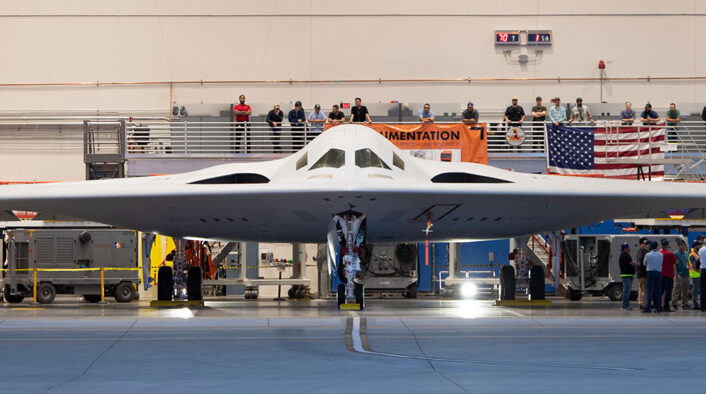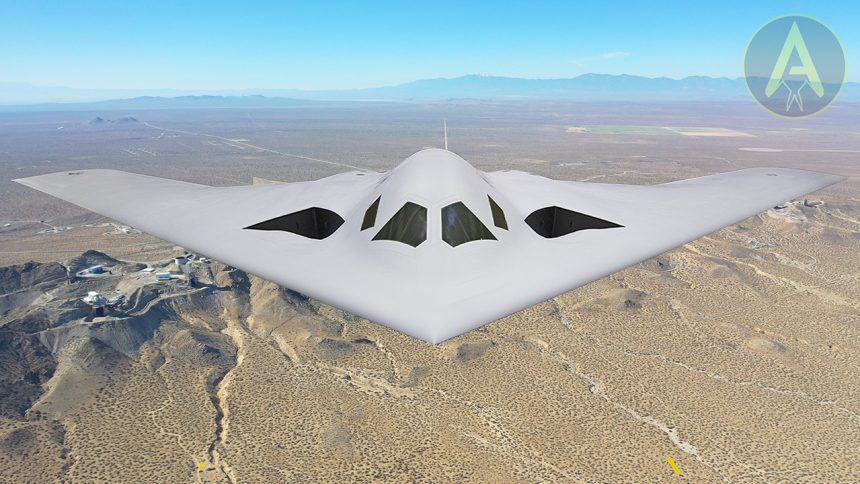The use of mature subsystems in the new platform was prioritized so that the program could focus on applying new technology.
A very interesting story was published a couple of days ago by Aviation Week, discussing some of the design choices of the B-21 Raider stealth bomber and adding few more details. The article, written by world-renowned stealth expert Bill Sweetman, is also accompanied by a detailed interactive graphics with all the known features of the bomber.
New photos of the B-21 Raider sixth generation stealth bomber were released during the 2023 Air, Space & Cyber Conference, showing the aircraft in a much more advanced state of completion as engine runs are already in progress at Northrop Grumman’s Palmdale facility. Many new details emerged from these photos, starting from a more accurate estimate of the dimensions of the B-21, with a wingspan estimated at 132 ft compared with the B-2’s 172 ft.
The planform, one of the key aspects of the aircraft still uncertain, was not yet unveiled in the photos. However, Aviation Week mentions that the planform was depicted in a video that accompanied a presentation by Gen. Duke Richardson, commander of the U.S. Air Force Materiel Command, at the 2023 ASC Conference.
The B-21, although smaller, closely resembles the B-2 bomber it will replace and its planform is influenced by the need to accommodate key features of the design, such as complex inlets and exhausts to contain IR and radar signature and a large weapon bay within the flying-wing profile, all while staying within a maximum thickness-to-chord ratio compatible with efficient flight above Mach 0.8. Right now, the planform appears similar to the B-2’s original one, before it had to be modified to improve controllability.

Like the B-2, the B-21 makes use of the “flying saucer” design approach, originally proposed by Skunk Works founder Clarence “Kelly” Johnson. In a paper he wrote in 1975, Johnson says “a shape similar to flying saucers, with a sharp edge and no protuberances, has a very low radar cross-section without any anti-radar treatment.” An evolved profile based on this approach is visible on the Raider, together with some features inherited from the X-47B UCAV.
In fact, according to Aviation Week, the design of the B-21 Raider indicates a conservative approach by the U.S. Air Force’s Rapid Capabilities Office, reducing risk by using mature subsystems in a new platform so that the program can focus on applying new technology. A similar approach was used for the design of the F-117 Nighthawk.
An example of the use of mature subsystems is the design of the inlets, which Aviation Week says is a close match to unclassified imagery from Pratt & Whitney presentations dating back to the early 2010s. The same could be said for the engine, as Pratt & Whitney discussed the PW9000 turbofan, based on the core of the PW1000G commercial engine mated to a direct-drive fan with a 4:1 bypass ratio, as a future bomber powerplant in 2010 and Aviation Week says the B-21’s center-body section and inlets match the ones that would be required by a medium-bypass engine.
Northrop Grumman also used, where possible, commercial components and systems, reducing costs and taking advantage of long-lasting commercial supply networks, according to Doug Young, the company’s vice president and general manager for strike systems. The electronic warfare system of the B-21 is closely related to another mature system, the F-35’s ASQ-239.
The digital design of the B-21 was fundamental for this approach, as it allowed to find and fix errors and problems early in the design process. This, in turn, allowed to build the test vehicle as a production representative aircraft, which already incorporates all the core systems and component.









